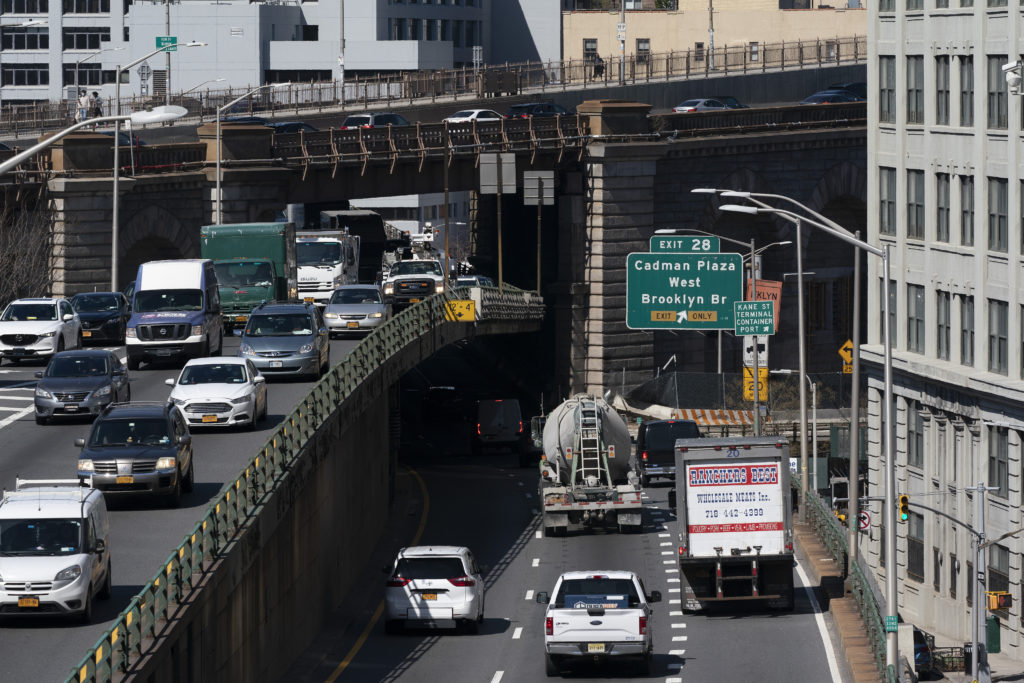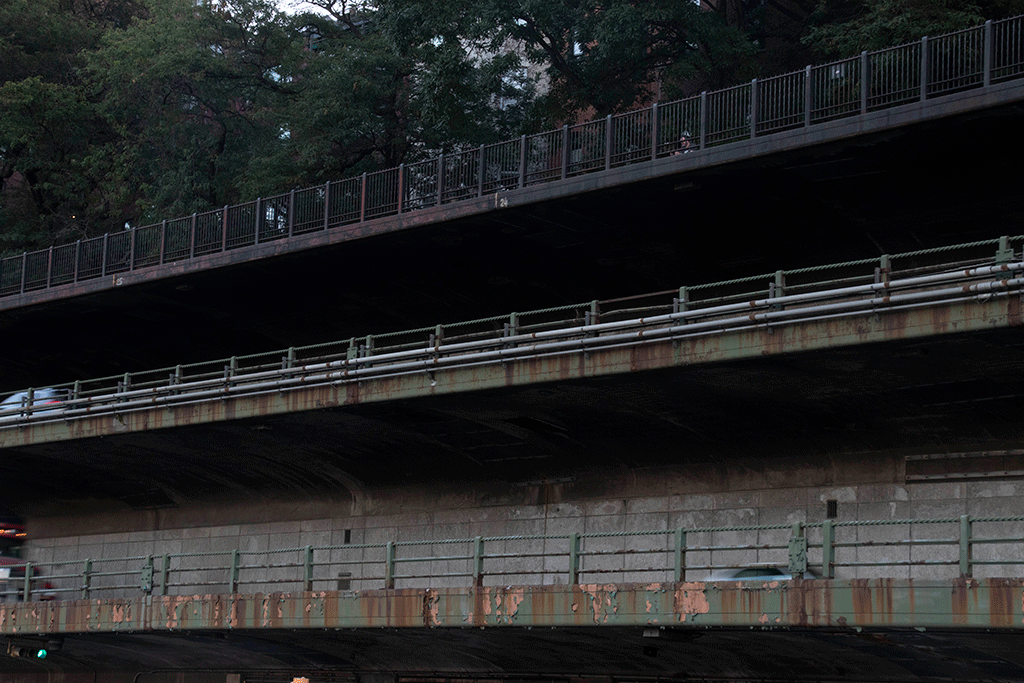Research in Action on the Brooklyn Queens Expressway
Over the past 6 years, C2SMARTER has completed several research projects on a section of the BQE, work that culminated in unprecedented overweight truck enforcement legislation in late 2023.
overview
Infrastructure systems constitute a major part of the national investment and are critical for the mobility of our society and its economic growth and prosperity. The United States has an estimated $25 trillion investment in civil infrastructure systems, including all installations that transport, transmit, and distribute people, goods, energy, resources, services, and information. Road pavements, bridges, and other infrastructure systems are considered assets that require maintenance and proper management to guarantee their functionality to the U.S. economy, yet, the degree of deterioration due to the exposure to natural and manmade hazards such as overweight trucks is relatively high.

In New York City, major decisions must be made to allocate limited funding for repair, maintenance, and rehabilitation of the infrastructure network. These decisions should be based on integrating various sources of information to control the infrastructure systems and their deterioration using structural models coupled to traffic modeling at the network level, to help perform economic forecasting and lifecycle cost analysis.
Today on the BQE
The BQE is a critical unique New York City asset; one whose importance is underscored by its immense usage by various modes of transport on a daily basis. This consistent and longstanding use has led to wear and tear which will require long term remedy by the city to ensure its health and survival.
In the meantime, Structural Health Monitoring (SHM) is being undertaken to keep the bridge safe for the more than 153,000 average vehicles who use it daily. C2SMARTER data, largely collected by Weigh in Motion (WIM) sensors, has shown that there are illegally overweight trucks damaging the structure, which city officials are now taking unprecedented steps to mitigate.

In 2017, a multi-year contract was initiated with NYCDOT for SHM deployment. The partnership, which relies upon C2SMART research/analysis and NYCDOT installation/maintenance, led to the testbed’s finalized installation in 2021.
Learn more.
In 2021, the New York State Senate and Assembly passed the BQE Overweight Truck Bill, signed into law effective 2022 by Governor Kathy Hochul.
This unprecedented legislation backed by C2SMART data authorizes automated overweight enforcement on a portion of the BQE, which began in November 2023 after a 90 day warning period.
Learn more.
SHM mitigates short-term problems using smart sensors to monitor the structural health and overall performance of infrastructure.
WIM devices capture axle weights and vehicle weights of moving vehicles. Vehicles are weighed without stopping, making it a more efficient method to collect data.
Learn more.
City officials have long recognized the need to ensure the health of one of New York’s greatest assets. In 2019, C2SMART Directors served on an Expert Panel initiated by the New York City Mayor’s Office to collect insights into the Brooklyn Queens Expressway and make skilled recommendations based on their findings.
Learn more.

Research Projects
YEAR 1
Monitoring and Control of Overweight Trucks for Smart Mobility and Safety of Freight Operations
PI: Hani Nassif; Co-PIs: Kaan Ozbay
YEAR 2
Development of A-WIM System for Effective Enforcement of OW Trucks to Reduce their Socioeconomic Impact on Major Highways
PI: Hani Nassif; Co-PIs: Kaan Ozbay, Chaekuk Na
YEAR 3
Implementation and Effectiveness of Autonomous Enforcement of OW Trucks in an Urban Infrastructure Environment
PI: Hani Nassif; Co-PIs: Kaan Ozbay, Chaekuk Na
YEAR 4
Integration and Operation of an Advanced Weigh-in-Motion (A-WIM) System for Autonomous Enforcement of Over Weight Trucks
PI: Hani Nassif; Co-PIs: Kaan Ozbay, Chaekuk Na
YEAR 5
Evaluation of Integrated OW Enforcement System using High Accuracy WIM System and Non-Proprietary ALPR System
PI: Hani Nassif; Co-PIs: Kaan Ozbay, Chaekuk Na
YEAR 6
Impact of WIM-based Direct Enforcement on the Service Life of Bridges
PI: Hani Nassif; Co-PIs: Kaan Ozbay, Chaekuk Na
Agency Partnership
In 2017, a multi-year contract was initiated with New York City’s Department of Transportation (NYCDOT) for Structural Health Monitoring (SHM) deployment. The partnership, which includes C2SMART research/analysis and NYCDOT installation/maintenance, led to the testbed’s finalized installation in 2021.
This research effort has also led to a change in national standards regarding WIM system certification for automated overweight enforcement. The update, as seen in the NIST Handbook 44 Section 2.26 Amendment, provides an enhanced certification procedure to use the WIM system for the automation of weight limit enforcement in collaboration with FHWA, the Specification and Tolerance (S&T) Committee of the National Conference on Weights and Measures (NCWM), regional Weights and Measures Associations, and other stakeholders.

Representatives from C2SMART attended and presented at all national meetings for NWCM (National Conference on Weights and Measures) and all regional associations’ meetings (NEWMA, SWMA, WWMA, and CWMA).


April 2023 Demonstration at Madison SWEF, WI
The result of this research and implementation, spread nationwide, will protect the country’s infrastructure and ensure passenger and truck safety, without depending on limited law enforcement resources.
Mayor's Expert Panel
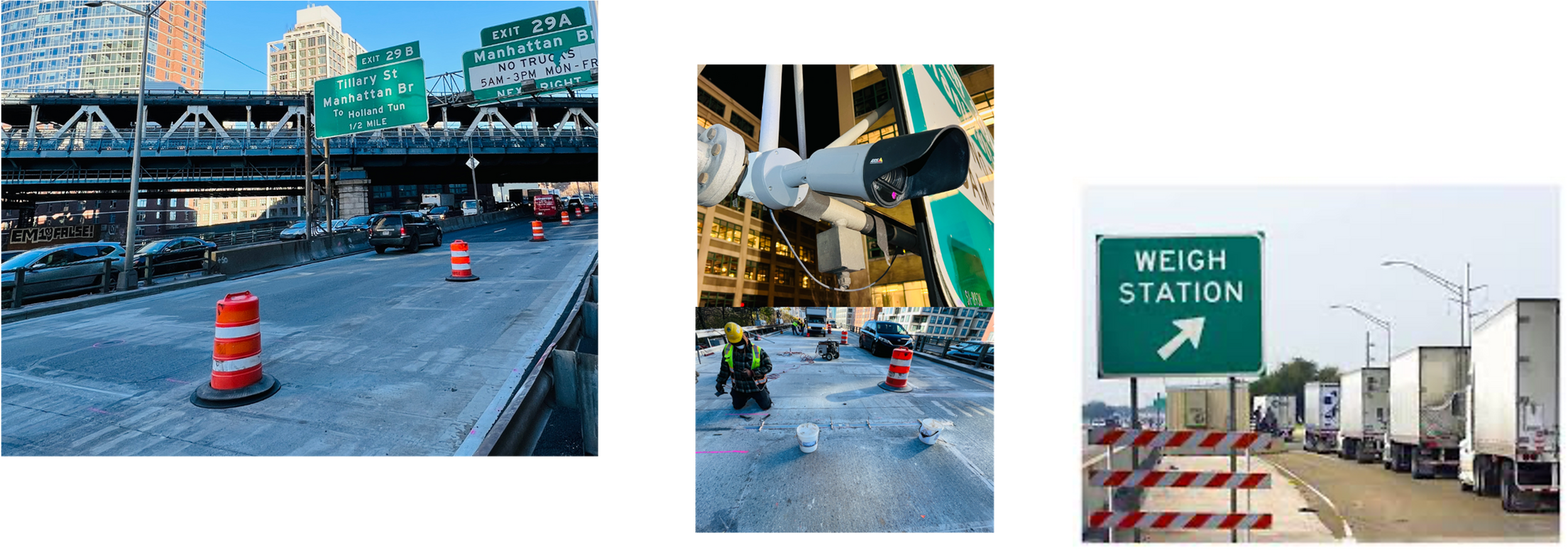
In 2019, C2SMART Directors served on an Expert Panel initiated by the New York City Mayor’s Office to collect insights into the Brooklyn Queens Expressway and make recommendations based on their findings. Through this panel, researchers gained access to the roadway to install sensors on cantilevered structure.
Industry partner Kistler was selected as the sensor provider; Kistler was chosen to their products’ superior performance. Data collected from the sensors indicated that 10% of trucks were overweight; some trucks were shown to be extremely heavy, >2 times the FHWA limit of 80 kips.

C2SMART’S data indicated a need for immediate action and led to expert recommendations:
- Permanent lane reductions
- Designated and wide shoulders
- Demand management plan to reduce BQE volumes by 15% or more
These recommendations led to Mayor de Blasio signing an executive order to better enforce overweight trucks as well as to commission repairs to the BQE.


Legislation for Automated Enforcement
In 2021, the New York State Senate and Assembly passed the BQE Overweight Truck Bill, signed into law effective 2022 by Governor Kathy Hochul. This unprecedented legislation backed by C2SMART data authorizes automated overweight enforcement on a portion of the BQE.
The legislation authorized the program’s kickoff, which began in November 2023. After a 90-day warning period, overweight trucks became subject to a $650 fine per violation (either or both of gross weight and axle weight). The C2SMART team integrated A-WIM system, Automated License Plate Recognition, and other technologies to identify the violators and the NYC enforcement unit mails notice of liability to truck owners.
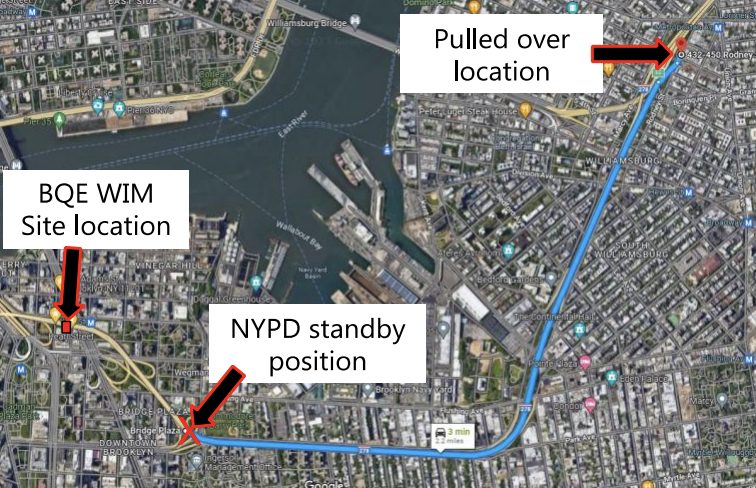

Warning Period
During the first full week of the warning period in August, 344 warnings were issued to overweight vehicles, which declined to 153 by the end of October. Beginning on November 13, 2023, overweight trucks became subject to a $650 fine per weight limit violation.
Vehicles are weighed using sensors in the roadbed and documented through the use of various cameras.

Throughout the warning period, fewer overweight trucks were being caught on the monitored stretch. Fines started on November 13, 2023.

Enforcement
Less than a year after automated enforcement officially kicked off on the BQE, NYC DOT is already reporting a decline of 64% in illegally overweight trucks. During the first seven months of the program, a monthly average of 2,769 overweight trucks crossed the corridor. Prior to the launch, the same section saw a monthly average of 7,777 overweight trucks.

In July of 2024, NYC DOT announced that the unprecedented automated enforcement program led to a 64% reduction in overweight vehicles along the triple cantilever of the BQE.
Following the success of Queens-bound enforcement on the BQE, NYC DOT plans to launch WIM enforcement for Staten Island-bound traffic by the end of 2024.
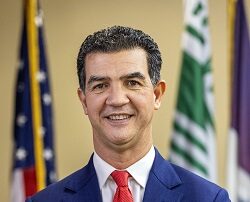
Press
- All
- Gallery Item



